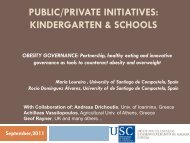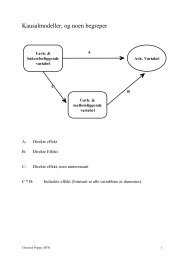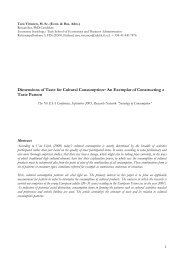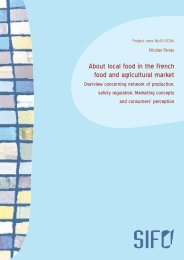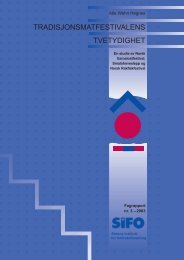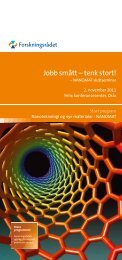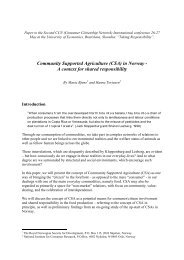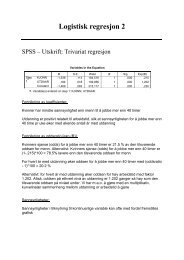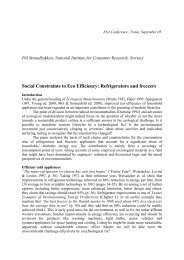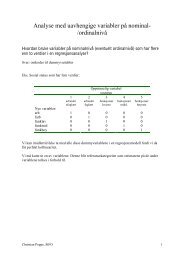Wool in Life Cycle Assessments and Design Tools - SIFO
Wool in Life Cycle Assessments and Design Tools - SIFO
Wool in Life Cycle Assessments and Design Tools - SIFO
- No tags were found...
You also want an ePaper? Increase the reach of your titles
YUMPU automatically turns print PDFs into web optimized ePapers that Google loves.
wool produc<strong>in</strong>g country <strong>in</strong> the world, wool is the primary product (Ellebäk Laursen, et al, 1997). It istherefore not evident how to allocate, <strong>and</strong> it is necessary to allocate differently for different cases.One should be careful when draw<strong>in</strong>g general conclusions from an LCA study. The results cannot, for<strong>in</strong>stance, be used without modifications, if fabrics for clothes are to be assessed. The use phasewould then be of greater importance, because of more frequent clean<strong>in</strong>g of the fabric. (Dahllöf)10. Reflections on LCA <strong>in</strong> generalTo conduct LCA reports is a time- <strong>and</strong> money consum<strong>in</strong>g activity that is mostly done by midsized <strong>and</strong>large companies. x% of Norwegian companies do not see any value added. Reports easily end up <strong>in</strong> adesk drawer. Money <strong>and</strong> time spent is useless if the result is not used as a basis for strategic choicesof environmental improvements at various po<strong>in</strong>ts <strong>in</strong> a life cycle of a product, or for f<strong>in</strong>d<strong>in</strong>g relevantenvironmental <strong>in</strong>dicators that can be used for future developments <strong>and</strong> compar<strong>in</strong>g.A lot of the criticism aga<strong>in</strong>st LCA comes from the LCA scientific community. Issues that are discussedare; wrong results as result of wrong def<strong>in</strong>ed system boundaries, (Callaghan og Allen: 1994),complicated data collection (Ayres: 1995), uncerta<strong>in</strong>ties on choice of method (Fava: 1997) <strong>and</strong>challeng<strong>in</strong>g <strong>in</strong>terpretations. (F<strong>in</strong>nveden: 2000)It is important to realize that LCA is one tool among other tools to evaluate environmental impacts.Other tools <strong>in</strong>clude Environmental Impact Assessment (EIA) <strong>and</strong> Susta<strong>in</strong>able Development Records(SDR) (Tillman et al, 1997)Generally LCA is focused upon what harm a product makes, count<strong>in</strong>g the negative impacts on theenvironment. Some positive impacts like recycled content or use of renewable energy are more <strong>and</strong>more be<strong>in</strong>g considered. Still it is not a tool for report<strong>in</strong>g good news, just the bad <strong>and</strong> the less bad.In the jungle of dataLCAs have different figures on the same impacts, depend<strong>in</strong>g on the many variables that def<strong>in</strong>e theanalyzed system. If the framework is not communicated well or not understood it is a source tomisunderst<strong>and</strong><strong>in</strong>gs <strong>and</strong> mis<strong>in</strong>terpret<strong>in</strong>g. Different databases use data from different global regions.Data change with time <strong>and</strong> technology, <strong>and</strong> many LCA are already old <strong>and</strong> outdated <strong>in</strong> their datafacts. This might get very confus<strong>in</strong>g <strong>and</strong> mislead<strong>in</strong>g to the user.One example; In a LCA on New Zeal<strong>and</strong> Mer<strong>in</strong>o (Barber <strong>and</strong> Pellow 2004) they refer to Frankl<strong>in</strong>Associates (1993) stat<strong>in</strong>g the average carbon dioxide emission factor for polyester to be 6,9 kgCO2/kg PET. Look<strong>in</strong>g <strong>in</strong>to Frankl<strong>in</strong> Associates (USA) studies on PET for dr<strong>in</strong>k<strong>in</strong>g bottles (2007) itstates 3,28 kg CO2/kg PET, which is more correspond<strong>in</strong>g with the European Eco<strong>in</strong>vent Database atthe same time(2008). Both figures are based upon average energy mix from the grid, both US <strong>and</strong>Europe.What happened? Has the production of PET changed? Has the energy <strong>in</strong>put <strong>and</strong> source changed?Was it a US number compared with an European number? Did Barber <strong>and</strong> Pellow (2006) mis<strong>in</strong>terpretthe numbers from Frankl<strong>in</strong> Associates like that the numbers were per kg <strong>and</strong> not per functional unit?Or did I miss someth<strong>in</strong>g when read<strong>in</strong>g? The answer may be found <strong>in</strong> all areas.Another example is the variety range <strong>in</strong> eg energy data. Risks <strong>in</strong> this case are <strong>in</strong>dividual<strong>in</strong>terpretations or be<strong>in</strong>g mistaken by accident, or not hav<strong>in</strong>g the necessary skills to <strong>in</strong>terpret the rightway, or by us<strong>in</strong>g old data. It also shows a possibility for manipulation of results by choos<strong>in</strong>g thepreferred data.15



